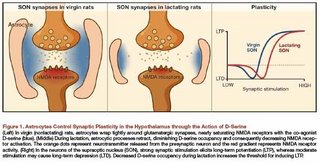The majority of cells in the nervous system are not neurons. They are glia. There are several subtypes of glia, one of which is astrocytes. Glia means glue. In general, people think of glia in their support role in the nervous system. Holding it together, disposing of waste and other menial tasks.
This little commentary here (
pdf) in the current
Cell describes a change in thinking that is occuring with regard to glia. They are stepping into a more active role. In this case, they modulate the ability of hypothalamic synapses to undergo plasticity. Compared to lactating rats, virgin rats have closer astrocyte encasement of synapses. The astrocytes release a chemical called D-serine into synapses that binds to a co-agonist site on NMDA receptors. NMDA receptor activation is considered the first checkpoint for increases in synaptic strength. More D-serine = more effective NMDA receptor activation.
In the study described, virgin rats have a lower threshold for LTP induction than do lactating rats. This is nicely illustrated below the fold.

So better glia encapsulation of synapses = more D-serine in synapses = more NMDAR activation = easier to undergo synaptic enhancement. This is in the hypothalamus mind you, not usually a major locus for memory studies. I'd like to see what's going on during these states in the hippocampus. For those of you interested in intelligence and Ashkenazis and all that business, you might note that the major abnormality of Einstein's brain was an greater glia to neuron ratio. I don't know what that means either.

